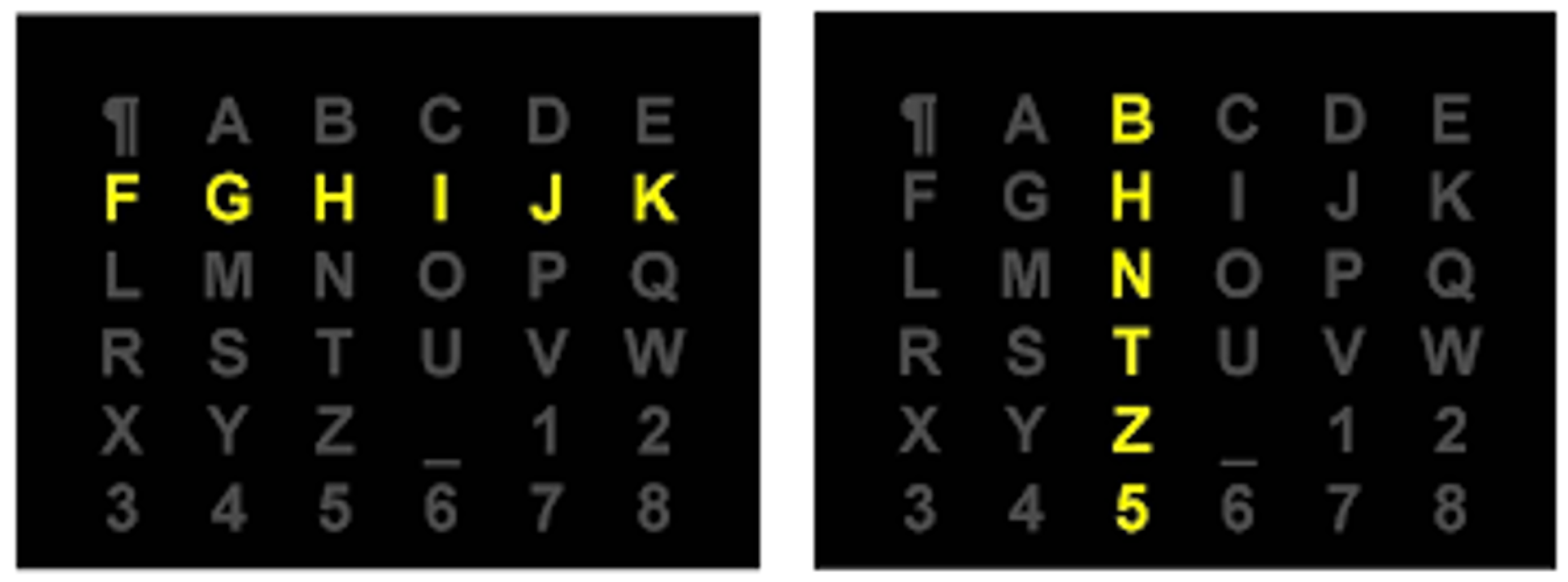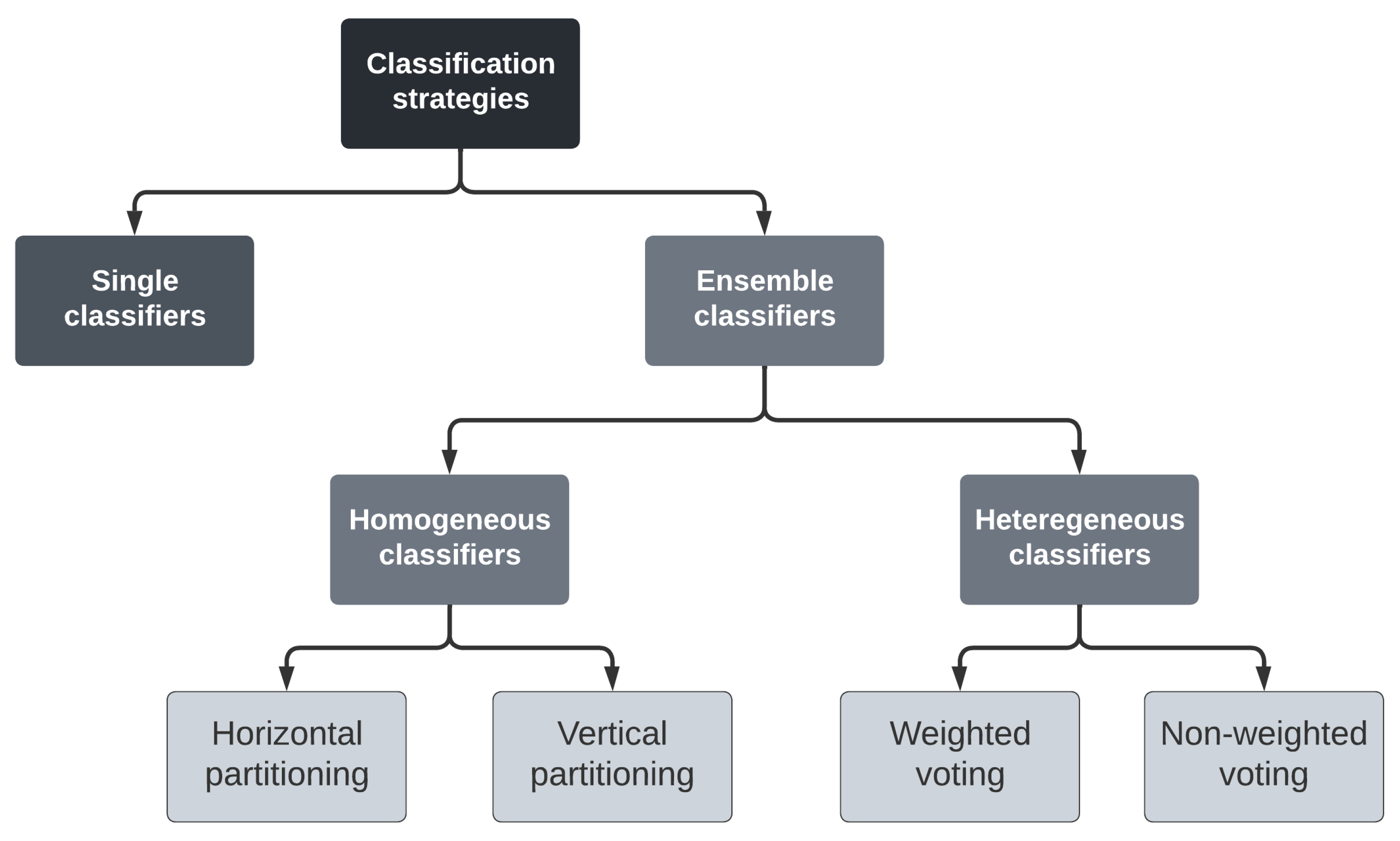In the case of ensemble classifiers, two options are possible. The first option is called Heterogeneous Ensemble Classifiers, which consists of training different classifiers using the same training dataset. The second option is called Homogeneous Ensemble Classifiers, which consists of training different instances of the same classifier using different partitions of the training dataset.
Let us consider a training dataset, denoted
D, comprising post-stimulus signals corresponding to the selection of
symbols (commands)
of
M.
where
is the
ith sequence
that occurs during the
jth selection. So, the dataset
D consists of
post-stimulus training signals.
4.2.1. Heterogeneous Ensemble Classifiers Strategy
This step is often known as decision-level fusion, where different modalities are utilized for separate training models. An aggregation function is used at the end to determine the final decision by combining the different prediction results of distinct models. In such a case, the whole training dataset
D is used to train
N different 2-class classifiers, leading to an ensemble of distinct classifiers. Every classifier
is trained to predict if a signal contains a P300 response or not. Every classifier
builds its prediction model. Thus every classifier
will customize the prediction method
, denoted
, according to its prediction model. The total number of trials used to train and build the model of every classifier is defined using the following expression:
There are two different approaches to building the final decision of this classification strategy: non-weighted voting and weighted voting.
- a.
Non Weighted Voting
In this case, the different classifiers play the same role to predict the selected symbol/command. Given a selection
, the corresponding
sequences of intensifications are parsed simultaneously by the
N distinct classifiers. Every classifier
calculates
and returns a row vector denoted
as follows:
such that
The results
obtained by the different classifiers
are then combined to calculate the global decision as follows:
returns a row vector denoted
such that
is the probability that the intensification which occurs in the jth row/column of M has elicited a P300 response.
Given a selection
, we can determine the user’s desired symbol by maximizing the results of the prediction function
. Using the values of the row vector
we identify the column and the row that have most probably elicited P300 responses. Considering
y is the number of the column of
M that has most probably elicited P300 responses. Thus,
y is the column number that maximizes the score
.
Let
x be the number of the row of
M that has most probably elicited P300 responses.
x is the number of the row that maximizes the score
.
Thus, we consider that the symbol of M is the most probably user’s desired symbol.
- b.
Weighted Voting
In this case, we apply the same strategy as the non-weighted voting approach except that the decisions of the involved classifiers are waved to generate the global decision. Every classifier
is assigned a weight denoted
that corresponds to the accuracy of
during the training phase. As such the results obtained by the different classifiers
are combined to predict the global decision using the following prediction function
to calculate the global decision as follows:
returns a row vector denoted
such that
is the probability that the intensification that occurs in the jth row/column of M has elicited a P300 response.
Given a selection , we can determine the user’s desired symbol by maximizing the results of the prediction function . Using the values of the row vector we identify the column and the row that have most probably elicited P300 responses. Let y and x be the numbers of the column and the row of M that has most probably elicited P300 responses, respectively. y and x are obtained by applying Equations (22) and (23), respectively.
Thus, we consider that the symbol of M is the most probably user’s desired symbol.
4.2.2. Homogeneous Ensemble Classifiers Strategy
In this case, the training dataset D is split into disjoint partitions (portions). Every partition is used to train an instance of the same 2-class classifier, leading to an ensemble of homogeneous classifiers. Every classifier is as such trained to predict if a signal contains a P300 response or not. The training dataset D could be split into two different approaches: Vertical or Horizontal partitioning.
- a.
Horizontal Partitioning
We remind that the dataset contains selections . Every selection is composed of sequences of intensifications denoted by . represents the jth sequence of the ith selection.
In the horizontal partitioning strategy, the signals of the training dataset
D are spread over
partitions denoted
each of which is defined as follows:
A partition
contains all
ith sequences of intensifications of the
selections. As such, the partition
contains all first sequences of the
selections, the partition
contains all second sequences of the
selections and so on. The obtained partitions have to satisfy the following properties:
Every partition
is composed of
sequences of intensifications. Hence, a partition
contains
post-stimulus signals.
Every partition
is used to train a single 2-class classifier
, leading to an ensemble of
classifiers. Every classifier
is as such trained to predict if a signal corresponds to a P300 response or not. Thus, the total number of trials used to train every classifier is defined using the following expression:
Given a selection
, the corresponding
sequences of intensifications are parsed simultaneously by the
classifiers. Every classifier processes a single sequence of the
sequences of
. Thus, a classifier
will parse the
sequence
of
. Every classifier
calculates
as follows:
Every classifier
returns a row vector denoted
whose values are calculated as follows:
is the probability that the intensification, whatever its order/rank, of the
jth row/column of
M that happens during the
ith sequence of intensifications
has elicited a P300 response or not. The different results (row vectors)
calculated by the different classifiers
are then combined to calculate the global decision as follows:
returns a row vector denoted
such that
is the probability that the intensifications that occur in the jth row/column of M have elicited P300 responses.
Given a selection , we can identify the column and the row that have most probably elicited P300 responses by maximizing the results of the prediction function . Let y and x be the numbers of the column and the row of M that has most probably elicited P300 responses, respectively. y and x are obtained by applying Equations (22) and (23), respectively. Thus, we consider that the symbol of M is the most probable user’s desired symbol.
- b.
Vertical Partitioning
In the vertical partitioning strategy, the selections are spread over a set of classifiers. So, we defined a collection composed of
N different instances of the same classifier. Then, we split equally the
selections over the different instances
. Thus, every classifier
will be trained on a subset of the training dataset composed of
selections. As such, every instance
of the classifiers will be assigned a partition defined as follows:
A partition contains successive selections and satisfies the properties described by expression (33).
Every partition
contains
post-stimulus signals.
Every partition
is used to train a 2-class classifier
, leading to an ensemble of
N classifiers. Every classifier
is as such trained to predict if a signal contains a P300 response or not. Thus, the total number of trials used to train every classifier is defined using the following expression:
Given a selection
, the corresponding
sequences of intensifications are parsed simultaneously by the
N classifiers. Every classifier
calculates
and returns a row vector denoted
(Equation (
18)) whose values are calculated using Equation (
19).
The different results (row vectors)
calculated by the different classifiers
are then combined to calculate the global decision as follows:
returns a row vector denoted
such that
is the probability that the intensification that occurs in the jth row/column of M has elicited a P300 response.
Given a selection , we can identify the column and the row that have most probably elicited P300 responses by maximizing the results of the prediction function . Let y and x be the numbers of the column and the row of M that has most probably elicited P300 responses, respectively. y and x are obtained by applying Equations (22) and (23), respectively. Thus, we consider that the symbol of M is the most probable user’s desired symbol.










